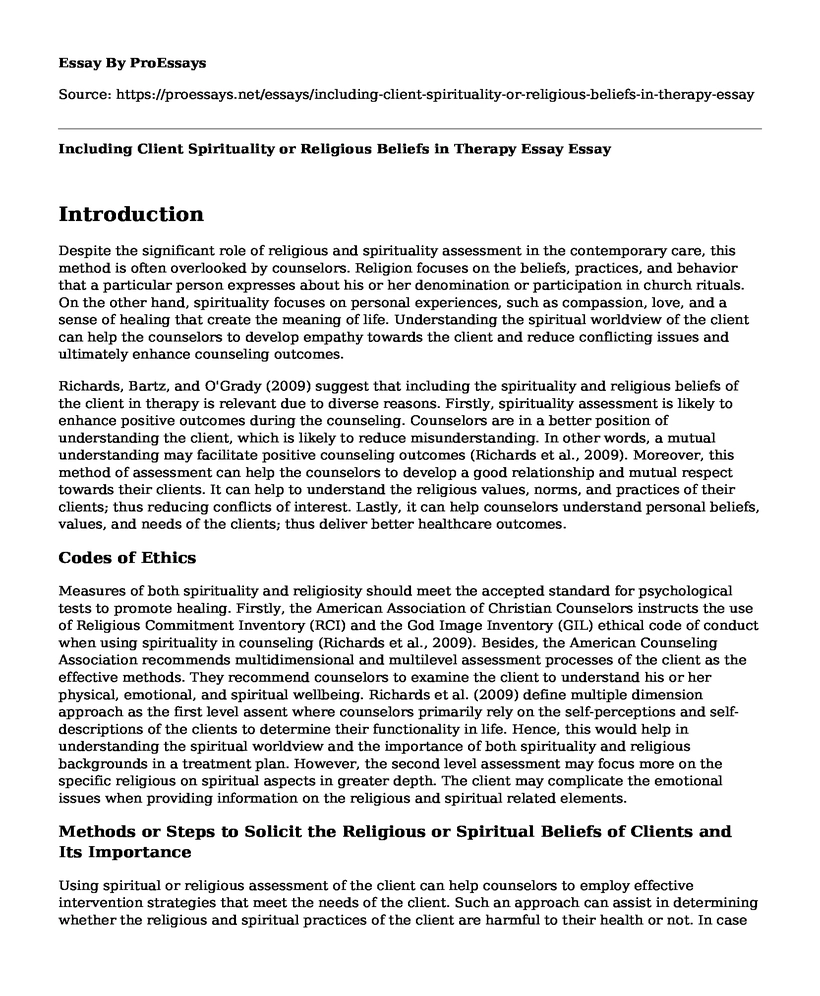Introduction
Despite the significant role of religious and spirituality assessment in the contemporary care, this method is often overlooked by counselors. Religion focuses on the beliefs, practices, and behavior that a particular person expresses about his or her denomination or participation in church rituals. On the other hand, spirituality focuses on personal experiences, such as compassion, love, and a sense of healing that create the meaning of life. Understanding the spiritual worldview of the client can help the counselors to develop empathy towards the client and reduce conflicting issues and ultimately enhance counseling outcomes.
Richards, Bartz, and O'Grady (2009) suggest that including the spirituality and religious beliefs of the client in therapy is relevant due to diverse reasons. Firstly, spirituality assessment is likely to enhance positive outcomes during the counseling. Counselors are in a better position of understanding the client, which is likely to reduce misunderstanding. In other words, a mutual understanding may facilitate positive counseling outcomes (Richards et al., 2009). Moreover, this method of assessment can help the counselors to develop a good relationship and mutual respect towards their clients. It can help to understand the religious values, norms, and practices of their clients; thus reducing conflicts of interest. Lastly, it can help counselors understand personal beliefs, values, and needs of the clients; thus deliver better healthcare outcomes.
Codes of Ethics
Measures of both spirituality and religiosity should meet the accepted standard for psychological tests to promote healing. Firstly, the American Association of Christian Counselors instructs the use of Religious Commitment Inventory (RCI) and the God Image Inventory (GIL) ethical code of conduct when using spirituality in counseling (Richards et al., 2009). Besides, the American Counseling Association recommends multidimensional and multilevel assessment processes of the client as the effective methods. They recommend counselors to examine the client to understand his or her physical, emotional, and spiritual wellbeing. Richards et al. (2009) define multiple dimension approach as the first level assent where counselors primarily rely on the self-perceptions and self-descriptions of the clients to determine their functionality in life. Hence, this would help in understanding the spiritual worldview and the importance of both spirituality and religious backgrounds in a treatment plan. However, the second level assessment may focus more on the specific religious on spiritual aspects in greater depth. The client may complicate the emotional issues when providing information on the religious and spiritual related elements.
Methods or Steps to Solicit the Religious or Spiritual Beliefs of Clients and Its Importance
Using spiritual or religious assessment of the client can help counselors to employ effective intervention strategies that meet the needs of the client. Such an approach can assist in determining whether the religious and spiritual practices of the client are harmful to their health or not. In case they are harmful, it is crucial to decide on the best approach to use that meet the accepted code of ethics. Thus, questionnaire and interview methods can help gather in-depth information about the client. The complex nature of spirituality and religious issues has made it difficult to make recommendations concerning the best approach to employ in the assessment of the client. Both terms pose controversial and complex issues to the process. Analysis of this article will provide an insight on how the two concepts serve as a catalyst to enable counselors to clarify the effective approach for attaining the treatment needs of the client.
Besides, the use of case study approach can help in determining how important spirituality is to the client. A case study analysis conducted revealed that spiritual assessment may be helpful. The research showed that there is no right process of handling the case but gathering adequate information about the religious and spiritual background of the client, as well as beliefs relevant to the treatment plan is vital (Richards et al., 2009). Although the general approach employed in the treatment plan may change based on the religious orientation of the client, there may be considerable variations in the way the counselors implement certain interventions and resolve specific problems.
Reference
Richards, P. S., Bartz, J. D., & O'Grady, K. A. (2009). Assessing religion and spirituality in counseling: Some reflections and recommendations. Counseling and Values, 54(1), 65-79.
Cite this page
Including Client Spirituality or Religious Beliefs in Therapy Essay. (2022, Aug 15). Retrieved from https://proessays.net/essays/including-client-spirituality-or-religious-beliefs-in-therapy-essay
If you are the original author of this essay and no longer wish to have it published on the ProEssays website, please click below to request its removal:
- Compare and Contrast Essay on Christianity and Shintoism Approach Towards Healthcare
- Relationship Between Islam and Protestant Reformation Essay
- Essay Sample on The Existence of God
- Diary Entry on Abu Muslim's Army Essay Example
- Film Analysis Essay on An Interview With God: The Conversation That Shakes Faith
- Exploring Christianity & Incorporating Other Faiths: The 'Law of Universe' - Essay Sample
- Essay on 33% of Americans Suffer High Stress Levels: Impact on Health







